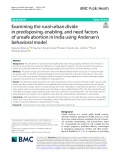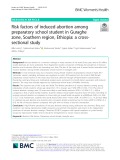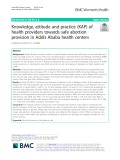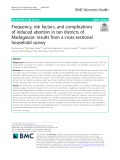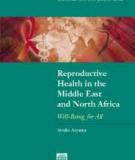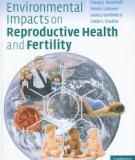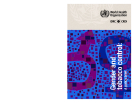
Unsafe abortion
-
The prevalence of unsafe abortions significantly varies with geography; therefore, more research is needed to understand the rural-urban differences in unsafe abortion practices in India. The present study aims to explore the rural-urban differences in predisposing, enabling, and need factors of unsafe abortion in India.
 14p
14p  viferrari
viferrari
 28-11-2022
28-11-2022
 12
12
 2
2
 Download
Download
-
Induced abortion is a common undergo in many societies of the world. Every year, around 20 million unsafe abortions are done worldwide. From fragmented studies conducted in Ethiopia, the prevalence of induced abortion and its adverse effects are increasing over time.
 7p
7p  vitokyo2711
vitokyo2711
 31-08-2020
31-08-2020
 8
8
 2
2
 Download
Download
-
Unsafe abortion remains a reality for many Ethiopian women and will remain so until safe abortion is more accessible across the country. The house of representatives of Federal Democratic Republic of Ethiopia (FDRE) revised the abortion law and Ministry of Health (MoH) of FDRE developed a revised technical and procedural guideline for safe abortion services in Ethiopia; emphasizing the need to increase knowledge and practice of health service providers on safe abortion care (SAC) and access to safe terminations of pregnancy at high standard and quality.
 10p
10p  vitokyo2711
vitokyo2711
 31-08-2020
31-08-2020
 10
10
 3
3
 Download
Download
-
Unsafe abortion accounts for nearly 60% of all gynecologic admissions and almost 30% of all obstetric and gynecologic admissions. Studies on abortion in Ethiopia have given less attention to women’s perceptions and experiences of abortion laws.
 10p
10p  vitokyo2711
vitokyo2711
 31-08-2020
31-08-2020
 13
13
 2
2
 Download
Download
-
Madagascar has restrictive abortion laws with no explicit exception to preserve the woman’s life. This study aimed to estimate the incidence of abortion in the country and examine the methods, consequences, and risk factors of these abortions.
 11p
11p  vitokyo2711
vitokyo2711
 31-08-2020
31-08-2020
 13
13
 2
2
 Download
Download
-
In Africa, as in many parts of the world, adolescent reproductive health is a controversial issue for policy makers and programme planners. Adolescents are particularly vulnerable to HIV and AIDS and to a host of other problems such as sexually transmitted infection, unwanted pregnancy, unsafe abortions, sexual abuse, female genital mutilation and unsafe circumcision. Yet many countries don’t have adolescent health policies and much remains to be done to ensure that adolescents can access appropriate sexual and reproductive health services....
 0p
0p  quatet
quatet
 12-01-2013
12-01-2013
 58
58
 3
3
 Download
Download
-
Ensuring universal access to SRH services and information is essential for achieving many, if not all, of the Millennium Development Goals (MDGs), especially those on maternal health, child survival, HIV and AIDS and gender equality [5]. Most maternal deaths can be prevented if there is skilled attendance at birth to cope with potentially fatal complications. Access to safe and effective family planning services and contraception empowers women to have more control over when to have children and lessens the incidence of unsafe abortions.
 5p
5p  ut_hai_can
ut_hai_can
 25-12-2012
25-12-2012
 52
52
 4
4
 Download
Download
-
In low- and middle-income countries, complications from pregnancy and childbirth are the leading cause of death among girls aged 15 to 19. And in 2008, there were an estimated three million unsafe abortions among girls in this age group. The adverse effects of adolescent childbearing also extend to the health of their infants. Perinatal deaths are 50% higher among babies born to mothers under 20 years of age than among those born to mothers aged 20 to 29. The newborns of adolescent mothers are also more likely to have low birth weight, with the risk of long-term effects....
 8p
8p  le_minh_nha
le_minh_nha
 25-12-2012
25-12-2012
 70
70
 9
9
 Download
Download
-
Unsafe abortions contribute to 13 percent of maternal deaths, about 68,000 per year. Abortion-related complications contribute to a relatively large share of maternal deaths in Latin America and the Caribbean (where legal restrictions on abortion are common) and to a lesser degree in Asia and Africa. The case fatality rate for abortions, however, is highest in Africa. Increases in the proportion of births assisted by a skilled birth attendant have been dramatic in Southern Asia, Eastern Asia and the Pacific and (from higher initial levels) in Latin America and the Caribbean.
 30p
30p  thankinhphanliet
thankinhphanliet
 21-12-2012
21-12-2012
 48
48
 3
3
 Download
Download
-
The primitive methods used for unsafe abortion show the desperation of the women. Surveys done in New York City before the legalisation of abortion on request documented the techniques in common use. 30 Of 899 women interviewed, 74 reported having attempted to abort one or more pregnancies; 338 noted that one of their friends, relatives, or acquaintances had done so. Of those reported abortion attempts, 80% tried to do the abortion themselves. Nearly 40% of women used a combination of approaches.
 12p
12p  connicquy
connicquy
 20-12-2012
20-12-2012
 53
53
 8
8
 Download
Download
-
Information on long-term health consequences of unsafe abortion is scarce. The WHO estimates that about 20–30% of unsafe abortions result in reproductive tract infections and that about 20–40% of these result in upper-genital-tract infection and infertility. An estimated 2% of women of reproductive age are infertile as a result of unsafe abortion, and 5% have chronic infections. 6 Unsafe abortion could also increase the long-term risk of ectopic pregnancy, premature delivery, and spontaneous abortion in subsequent pregnancies.
 8p
8p  connicquy
connicquy
 20-12-2012
20-12-2012
 46
46
 11
11
 Download
Download
-
Severity of complications is another important measure of effects on health. A standardised measure of the severity of complications was used in South Africa before and after legalisation of abortion on request in 1996. The proportion of women classified with severe complications (fever of 38°C or more, organ or system failure, generalised peritonitis, pulse 120 per min or more, shock, evidence of a foreign body, or mechanical injury) in South Africa fell substantially from 16·5% before legalisation to 9·7% after.
 13p
13p  connicquy
connicquy
 20-12-2012
20-12-2012
 51
51
 3
3
 Download
Download
-
About half of all deaths from unsafe abortion are in Asia, with most of the remainder (44%) in Africa. 6 The unsafe abortion mortality ratio (the number of unsafe abortion-related deaths per 100 000 livebirths) varies across regions. For the developing world as a whole, this ratio was estimated to be 60 in the year 2000. However, the ratio is much higher in eastern, middle, and western Africa (90–140), and is lower in northern and southern Africa, western and southeastern Asia, and Latin America and the Caribbean (10–40).
 24p
24p  connicquy
connicquy
 20-12-2012
20-12-2012
 55
55
 9
9
 Download
Download
-
Temporal trends in unsafe abortion have been inconsistent internationally (figure 2). Between 1995 and 2000, a decline of 5 or more percentage points took place in the unsafe abortion rate in eastern, middle, and western Africa, the Caribbean, and Central America. Other developing areas had no appreciable change in the rate of unsafe abortion. 6 Unsafe abortions vary substantially by age across regions: adolescents (15–19 years) account for 25% of all unsafe abortions in Africa, whereas the percentage in Asia, Latin America, and the Caribbean is much lower (figure 3).
 8p
8p  connicquy
connicquy
 20-12-2012
20-12-2012
 58
58
 8
8
 Download
Download
-
Community studies around the world indicate a higher magnitude of unsafe abortion than do health statistics. 3,11,12 In Zambia, the extent of maternal mortality from unsafe abortion is not generally known from health statistics; one study in which women were interviewed revealed that 69% of the respondents knew one or more women who had died from an unsafe illegal abortion. 12 Focus-group discussions and community-based studies in India11 revealed self-reported abortions in 28% of women, which is higher than figures derived from national service-delivery data.
 20p
20p  connicquy
connicquy
 20-12-2012
20-12-2012
 52
52
 7
7
 Download
Download
-
The possibility of unsafe abortion should be reduced through the provision of good quality, affordable and accessible abortion services, within the limits of the law. Quality family planning services also reduce the prevalence of abortion. Women and their communities should be sensitized to the importance of seeking timely care for the symptoms of reproductive tract infection, and for the need to receive clinical care under safe and clean conditions.
 59p
59p  le_minh_nha
le_minh_nha
 18-12-2012
18-12-2012
 50
50
 3
3
 Download
Download
-
By the 19th century, the major threats to community health were recognized as coming from poor housing, poor management of sewage and drainage, foul air in industrialized towns, unsafe drinking water, and inadequate control of pests. Early environmental health practitioners fought to remedy these defects and spurred the founding of the envi- ronmental health movement. In the 20th century, engineering and construction techniques went a long way towards removing the problems of air pollution, sewage, drainage and poor water quality in cities and towns.
 64p
64p  quygia123
quygia123
 02-11-2012
02-11-2012
 45
45
 1
1
 Download
Download
CHỦ ĐỀ BẠN MUỐN TÌM








